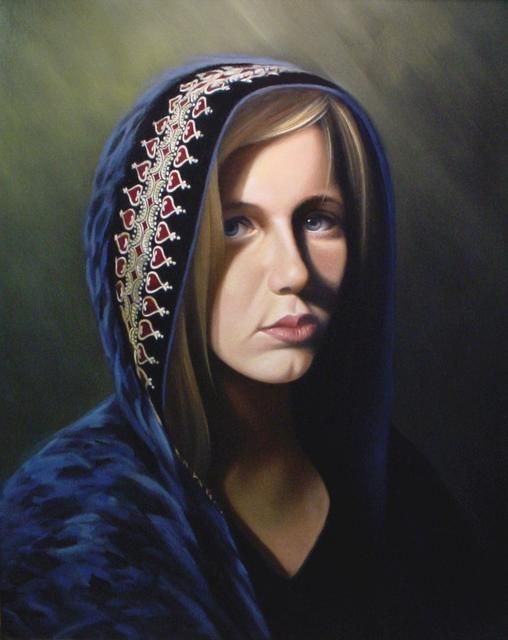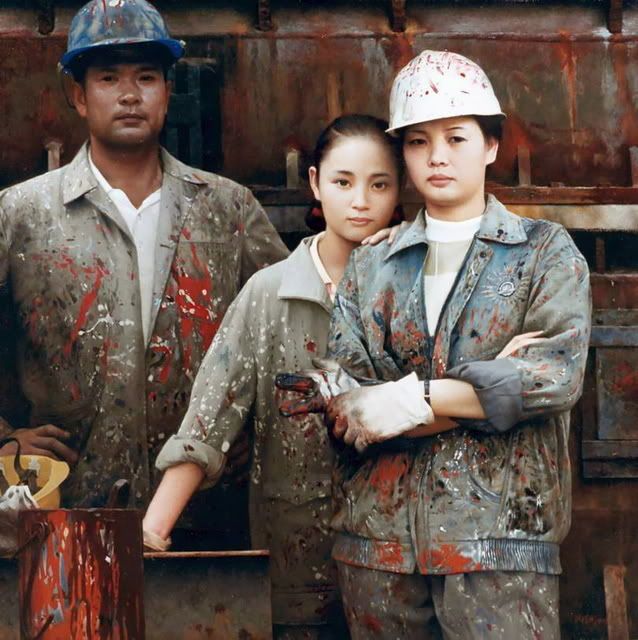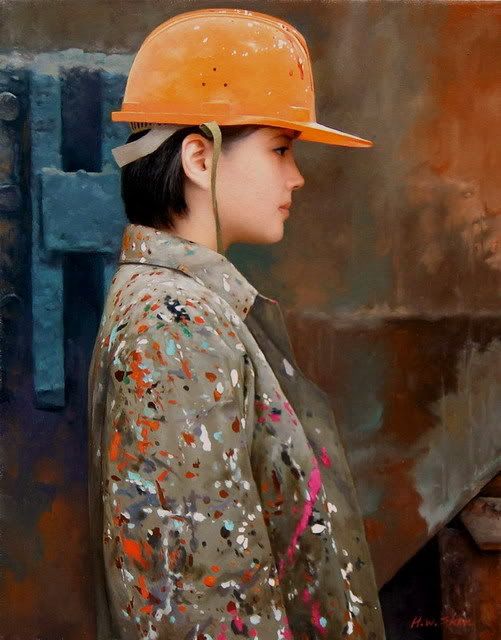Great realism, therefore, does not portray an immediately obvious aspect of reality but one which is permanent and objectively more significant, namely man in the whole range of his relations to the real world, above all those that outlast mere fashion. Over and above that, it captures tendencies of development that only exist incipiently and so have not yet had the opportunity to unfold their entire human and social potential. To discern and give shape to such underground trends is the great historical mission of the true...avant-garde.
Georg Lukács, "Realism in the Balance" (1938)
David Camp, "Blue Maiden's Gaze" (2005)
Despite the work of groups like the Art Renewal Center to assert the need for contemporary Realism against the bankruptcy of modernist painting, it is not terribly clear that contemporary Realism is itself ideologically solvent. Instead, too much of contemporary realist painting has no real ambition beyond decorative art. Individual figures, most often female, quite often nude are placed in settings that do little to provide any real context or provide one with narrative clues. Instead of being timeless, they are ahistorical, like the capitalism to which they are capitulations. They are commodities provided for consumption to an audience that has itself lost any sense of history. Thus realism regresses back to the earliest moment of Enlightenment aesthetics: art as entertainment. It becomes a completely private event that does nothing to challenge the viewer with respect to the place and form of art, or their own relation to the means or mode of production of works of art or any other form of labor. The universal human experience, by which it provides its own self-justification, is nothing more than that of the isolated, alienated, objectified individual who is unable to relate or comprehend themselves as part of some larger whole, and so disapproves of any art that does more than provide an unspeakable feeling to be enjoyed. Thus realism, in the contemporary moment, most often presents itself as nothing but a mirror in which we view our own fate. It provokes a sentimental gaze which quiets any need for real thought so that one can save all one's energy for the labor which is needed to sustain the growth of capital, experienced as the real truth of nature.
Han-Wu Shen, "Mother and Child by the River" (2002)
It is not hard to understand why realism gradually fell out of fashion. It is more than fad that drives art. The Pre-Raphaelites were inspired, at least in part, by the truth of nature. They, unlike their contemporaries, often went outside to paint their landscapes directly, etc. Perhaps with some exaggeration, Ruskin claimed that Millais could spend the day working on a spot of canvas that was no larger than a large coin. And indeed, Millais in his Pre-Raphaelite days paints in exquisite detail. But as the mode of production changes, so does art. As photography becomes increasingly available, certainly Millais's painstaking style becomes inefficient, but realism itself begins to lose its purpose. What is it that painting can do that a camera can not? Gradually the answer became clearer, though Whistler had already grasped the idea. Painting is to color, what music is to sound. The real content of painting, as the need for 'realist' content is historically displaced, is the relation of colors: harmonies, dischords, chaos and order, lights and darks, etc.
This need not mean that there cannot be a legitimate and contemporary Realism. But any realism that wishes to be true, not merely to its object, but also to its form, must never forget that painting is not either glorified or simplified photography, just a photography is not film. When painting does this, the difference in labor is lost and the painting itself becomes an image of what it ought be. Photography is a different media, one that deals in image, one that is increasingly able to bring us images from every aspect of life, often staged to communicate the truth of what happened (even more than the truth of what happened would), and which compensates, for better/for worse, for its lack of depth by providing an ever increasing barrage of those images. The concrete effect is the degeneration of realist (figure) painting into decorative and portraiture forms. Only a decorative piece can contain the simplicity that might vaguely make its completion an efficient possibility relative to some photographic comparison, while portraiture lives on, again without any real context, as a sign of status. A true Realism then cannot forego the study of color in order to be true to its form; in this historical moment, the form is the content.
Han-Wu Shen, "Co-Workers" (2000)
One contemporary realist who has developed this idea is Han-Wu Shen. Han-Wu, in important ways, already shows a superior grasp of realism relative to many of his contemporaries in that his work as whole develops its own narrative intellectual content and makes demands upon the 'reader'. Despite the fact that many of his paintings, taken in isolation, have the same decorative effect as one sees in the realists about whom I have been complaining, taken as a corpus, what one has in Han-Wu Shen is, on the one hand, a fairly sustained look at the tension between the Communist ideals/goals for China and the life of the rural peasantry who are still extremely common in the Chinese countryside, and on the other, an examination of the tension between those same peasants and their urban peers (and these are not two completely unrelated tensions of course).
But in and of itself, one would have to conclude that this would not be enough. A photo-journalist could accomplish this, not only with more ease, but with more power and narrative sophistication, than could someone limited by the labor time invested in oil and canvas figure painting. Yet Han-Wu Shen indicates he is quite aware of this problem and that indeed the labor of painting is not simply or even primarily about the rendering of figures. Its truth is no longer strictly found in its narrative content. Content and form must coincide. By far his most popular urban subject is the blue-collar painter. Here Han-Wu meditates on the nature of the art itself, and asks his audience and himself, "What is painting?". These 'common' painters, these laborers, these are his fellows and their art is not so very far from his own. Painting is about color. About providing a harmony of colors (and when one does not, it is always the possibility of harmony that makes the disharmony striking and meaningful). If one will, the proletarian painters are, not surprisingly, the ones who show in their practice the truth in painting. They have always known, says Han-Wu, that the color is the thing! But this is itself a narrative content one might reply. This takes us one final step further into his paintings of the painters. They themselves become explorations of color, canvases for Jackson Pollock to envy. They are built up like a mosaic so that as one is taken into the painting one loses sight of the painters and are drawn to what they want you to see, the beautiful arrangement of color, questions of harmony and form that lead back out to an evaluation of the whole work and ultimately the world of those painters and the painter himself. It leads to questions of Truth.
If and only if contemporary Realism can grasp the ideas that are being explored by those such as Han-Wu Shen can it possibly compete with the varioius (post-)modernisms as a truly meaningful form of painting/art, and indeed if it learns its lessons well, it may have the power to unite form and content in a manner beyond that of more abstract explorations of color. Great works of art, Adorno tells us, are those that not merely grasp the spirit of their age, but do so in such a way that the contradictions of that age are likewise allowed to appear. By allowing an apparently decorative realism to speak beyond itself Han-Wu Shen has perhaps done just that.
-LoA
Han-Wu Shen, "Young Red Guard" (c.2000)
Appendix
The first painting by Han-Wu Shen I saw was "Pregnant Worker." I was overwhelmed and awed; overjoyed almost to the point of tears. Here was such a powerful display of color and harmony. Han-Wu had consumed and consummated abstract art right there in that one jacket, that one denim work coat. I was stunned: oranges and browns and rust, blues, greys and steel, and that one touch of pink that is so perfect for being so out of place. This was justice: no glamour shot, no objectified subject for me to consume; this was real. It was the most real painting I had seen.....in.....I could not think when. Rapture!
Han-Wu Shen, "Pregnant Worker" (2000)
Friday, June 1, 2007
the possibilities of realism: a case for the art of han-wu shen
Subscribe to:
Post Comments (Atom)
2 comments:
Dear Lawrence
I wonder, do you really believe that a realism in art (any realism) is possible?
I mean, do you really believe that is possible to translate true experience (if ever we be fully able to be her masters) into icons?
(I’m asking that as a former painter who abandon the exercise of that art—but not the love for her—when he realized how vain is to try to be “true” in visual arts, and as a thinking man who regards photography as the most unreal and illusionary thing.)
Can you not see how outrageously utopian is Lukacs’ statement (even in his upside-down Hegelian …Platonism)?
I wonder
All the best
/v
well i have to admit to being a bit of a hegel-sympathizer myself so...yes, i see it in lukacs, but it is one of the things i like about him.
i suppose i do not think of it as a matter of needing to 'translate' experience but an attempt to come to terms with that which has already occurred within the sphere of reason. the need to understand is so basic to who we are, and the insistence that it can be iconically presented is the insistence that the truth can indeed be embodied. this, it seems to me, is the meaning of the doctrine of the incarnation: truth/reason (logos) became flesh.
so i remain hopeful that this is the Future for humanity.
finally, i would say that one has to come to terms, somehow, with the continued existence of realist painting in an age in which it would seem to have lost its raison d'etre. it somehow persists because it continues to contain a truth that is lacking elsewhere, and i am trying to somehow discern what that is. artists like han-wu shen and iman maleki are important: the question is "WHY?"!
i will put up another post in the next day or two that is more critical. and you can already see that i have concerns about realism in the short post i did on rossetti.
best wishes,
LoA.
Post a Comment